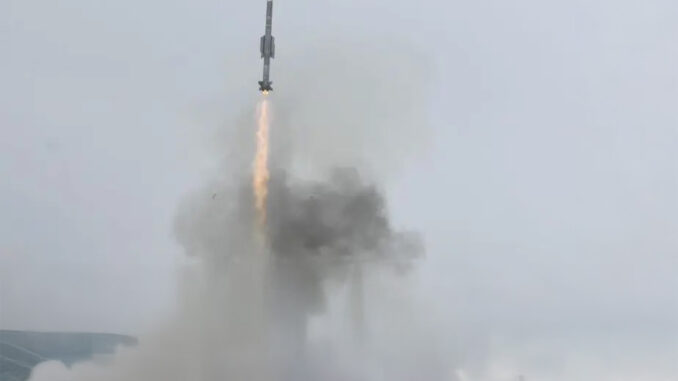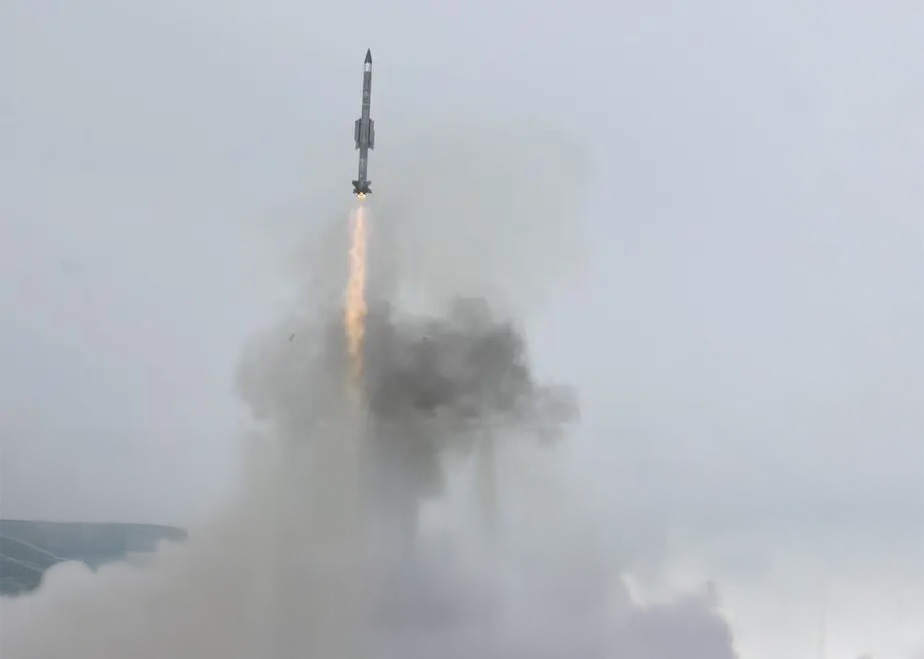
The VL-SRSAM has been successfully tested in India, demonstrating its air defence capabilities against low-altitude supersonic targets.
The Vertical Launch Short Range Surface-to-Air Missile (VL-SRSAM), developed by the Defence Research & Development Organisation (DRDO) and Bharat Dynamics Limited (BDL), was successfully tested in September 2024. Designed for Indian warships, it can engage aerial targets at distances of up to 50 km and at an altitude of 15 km. This rapid reaction missile defence system is intended to replace the Barak 1, offering better protection against supersonic threats. Its smokeless engine and advanced navigation systems make it a powerful and effective tool.
VL-SRSAM: a fast and effective defence missile
The VL-SRSAM is a vertically-launched surface-to-air missile designed to provide short-range defence for Indian Navy ships. Developed by the DRDO in collaboration with Bharat Dynamics Limited (BDL), this next-generation missile is specifically designed to counter low-flying supersonic threats, such as combat aircraft and unmanned aerial vehicles. With a range of 50 km and a maximum engagement altitude of 15 km, the VL-SRSAM is a strategic addition to the Indian fleet, providing a rapid reaction capability against aerial targets.
Its design includes a smokeless engine, limiting visual detection, which improves its effectiveness in complex combat situations. In addition, it is equipped with advanced electronic countermeasure systems, ensuring that it can reach its target even in the face of jamming attempts. These technical features enhance the defensive capability of ships, particularly in environments where radar detection and stealth are essential.
Technical characteristics of the VL-SRSAM missile
The VL-SRSAM missile has outstanding technical specifications that make it suitable for the Indian Navy’s requirements. It measures 3,931 mm in length, has a diameter of 178 mm and weighs 170 kg. Its architecture is based on a solid fuel engine, capable of providing a powerful initial thrust, sufficient to hit targets at high speed. The missile is equipped with four small wings to ensure stability during flight, maximising accuracy in all weather conditions.
The missile uses an inertial navigation system, coupled with a fibre-optic gyroscope, to guide the missile during the intermediate phase of flight. In the terminal phase, a radio frequency (RF) seeker takes over, guaranteeing precise acquisition of the target. This combination of technologies enables the missile to engage targets with great reliability. In addition, the missile is equipped with a highly fragmented warhead, activated by a radar proximity detonator, which explodes when the missile gets close enough to the target.

The role of the VL-SRSAM in naval defence
The VL-SRSAM is designed for installation on various types of warships, including destroyers, frigates, corvettes and aircraft carriers. Thanks to its vertical launch capability, it can be deployed rapidly in response to an imminent threat. Each Vertical Launch System (VLS) can hold up to 40 missiles, arranged in canisters in a ‘twin quad-pack’ configuration, meaning that each canister can hold eight missiles.
This arrangement enables compact storage and rapid launch of several missiles in sequence. The installation of multiple systems on a ship provides extensive defensive coverage, ensuring that Indian Navy ships can defend themselves effectively against high-speed air attacks. The planned replacement of the Barak 1 missile by the VL-SRSAM offers a significant upgrade to the Indian fleet’s defence capabilities, particularly in the face of new generations of aircraft and UAVs.
Strategic impact of the successful 2024 test
The test of the VL-SRSAM, carried out on 12 September 2024 at the Integrated Test Range (ITR) in Chandipur, marks an important step in the improvement of the Indian Navy’s defence capabilities. The test, aimed at a low-flying aerial target, confirmed the effectiveness of the missile’s improved components, such as the proximity detonator and the RF seeker. The test data, collected using the electro-optical radar tracking system and telemetry, verified the overall performance of the system under realistic conditions.
The importance of this test goes beyond the technical validation of the missile. The success of this test reinforces the credibility of the Defence Research & Development Organisation (DRDO) and the Indian Navy, demonstrating their ability to develop advanced defence technologies in response to the growing threats in the Indian Ocean region. In strategic terms, the VL-SRSAM will significantly enhance the defence capability of Indian warships, enabling them to engage enemy targets from considerable distances while remaining unobtrusive.
Strategic importance
The VL-SRSAM missile represents a significant advance in India’s air defence capabilities. Thanks to its advanced technical features, such as its smokeless engine, RF seeker and inertial navigation system, it offers a reliable and effective solution for protecting warships against supersonic air threats. The success of the September 2024 test underlines the strategic importance of this system in the regional context, and paves the way for widespread adoption within the Indian Navy.
With the programmed replacement of the Barak 1, the VL-SRSAM is expected to become a mainstay of short-range missile defence systems, helping to strengthen India’s maritime security in the years to come.
War Wings Daily is an independant magazine.